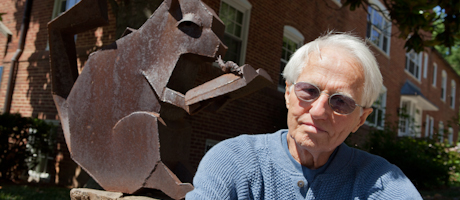By Menachem Wecker
Some professors practically live in libraries and archives. But Professor Who, as of June 3, perpetually camps opposite the Eckles Library on the Mount Vernon Campus.
The professor is neither a lazy scholar nor allergic to books; she’s a 31-inch tall – 24 without the pedestal – steel sculpture of a squirrel by the late Bangkok-born artist Slaithong Chengtrakul Schmutzhart, M.F.A. ’83.
Professor Who (1979) is one of two sculptures by the artist which her former husband, Berthold Schmutzhart, donated to the university in 2009. Free (1982), which depicts a seated woman with a bird on her lap, is in the Dimock Gallery awaiting placement, while Professor Who was installed earlier this month.
“Professor Who is one of many sculptures created to poke fun at our own awkwardness or naïveté in which we happen to find ourselves,” the artist wrote in her master’s thesis, titled Welded Steel Sculpture. “Many times the situation becomes too painful to cry so we laugh at it.”
The squirrel, who reads a book with a centipede crawling on its pages, is part of a social critique of the so-called “civilized” world, in which people don’t necessarily fit into a “premade package,” according to the artist.
“So we hide our shortcomings, pretend we know something or subdue our ego and talent not to become offensive to others,” she wrote.
The squirrel, perhaps the most heroic since Bullwinkle’s costar Rocky, resists society’s predefined roles.
“Professor Who is living exactly by the rules of her own class. She must be a learned person,” Ms. Schmutzhart wrote. “Is Professor Who studying the book or does she pretend? Only Professor Who knows.”
According to a Jan. 30, 2006 obituary in the Washington Post, Ms. Schmutzhart, who lectured in studio art, sculpture, ceramics, three-dimensional design and printmaking at Mount Vernon College from 1978 to 1991, was known for her “fanciful human and animal creations.”
The artist also taught at Marymount College, American University and the Corcoran College of Art and Design, where she was on faculty for 22 years before retiring as an associate professor in 2002.
According to Mr. Schmutzhart, the artist had a scholarship to GW, where H. Irving Gates, then associate professor of sculpture, said she distinguished herself by working particularly hard on her master’s thesis.
The thesis is packed with art historical, mythical and autobiographical background to the artist’s works – from the inspiration of the “found objects” sculptor Louise Nevelson collected to the yin and the yang and an invented prince of Capitol Hill who is bad at war but good at music.
But Ms. Schmutzhart cautioned that the sculptures, however compelling, still could be improved upon.
“If the work ever turned perfect, I might as well disappear, because there would not be anything more for me to do or accomplish,” she wrote.


